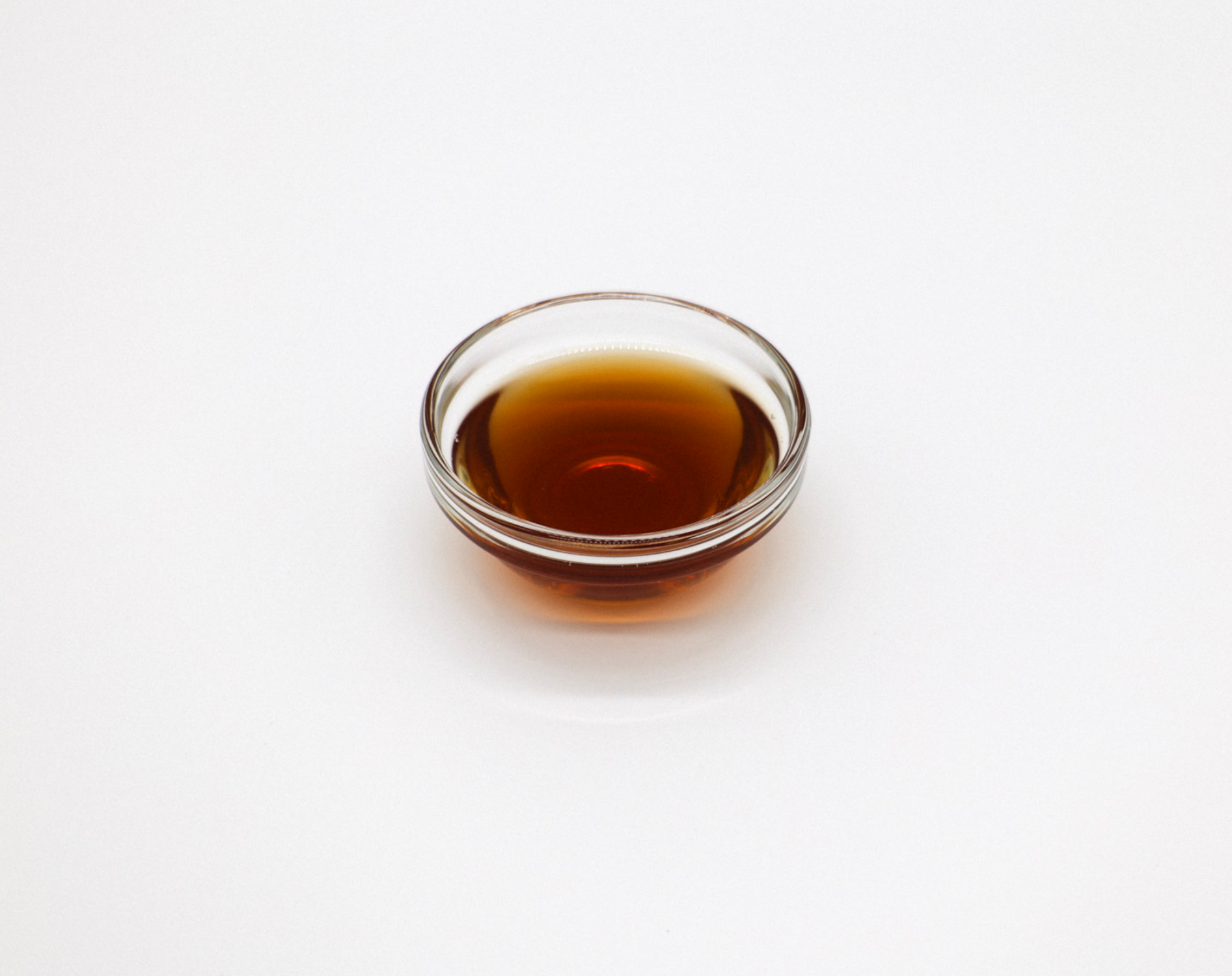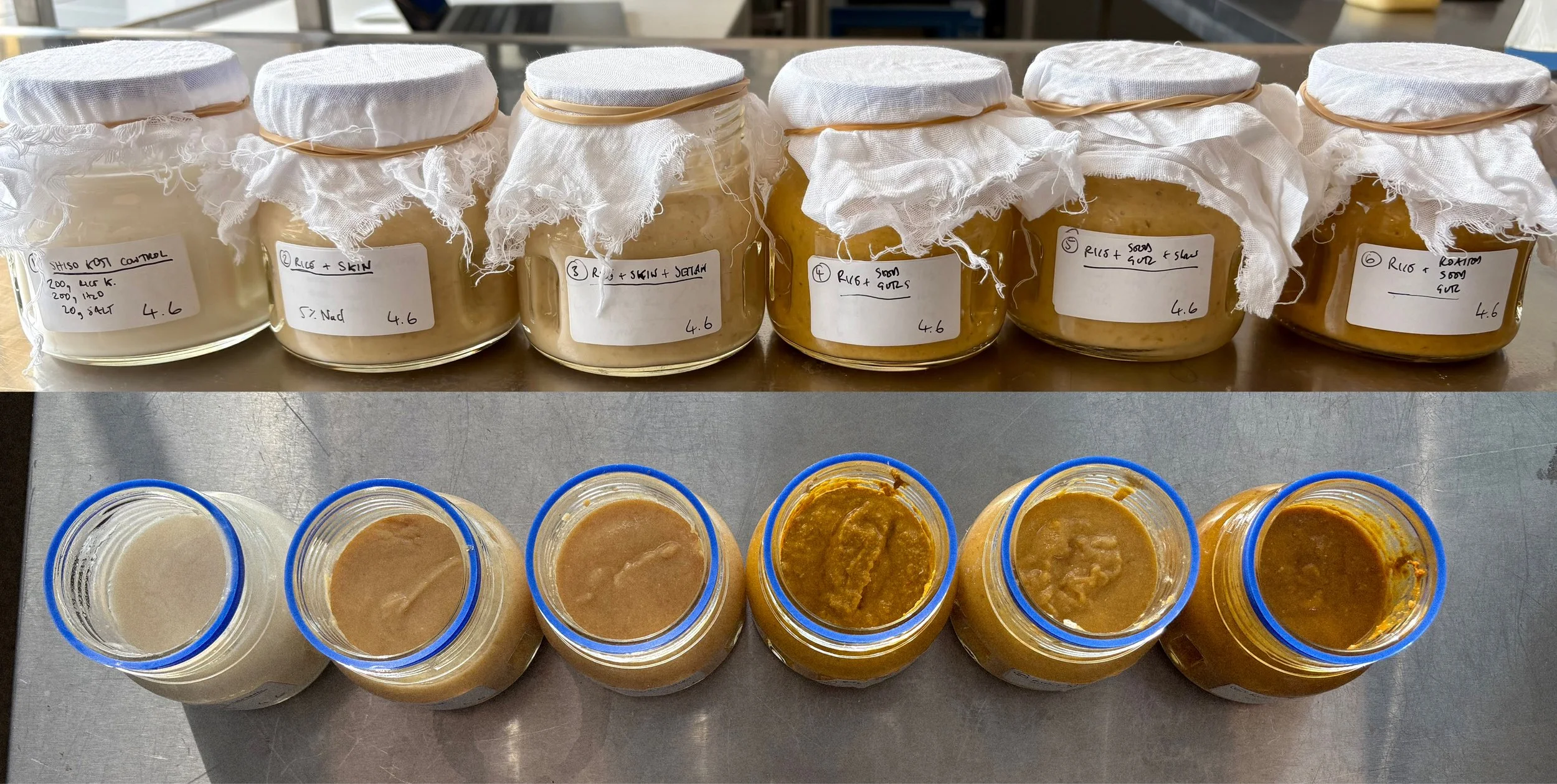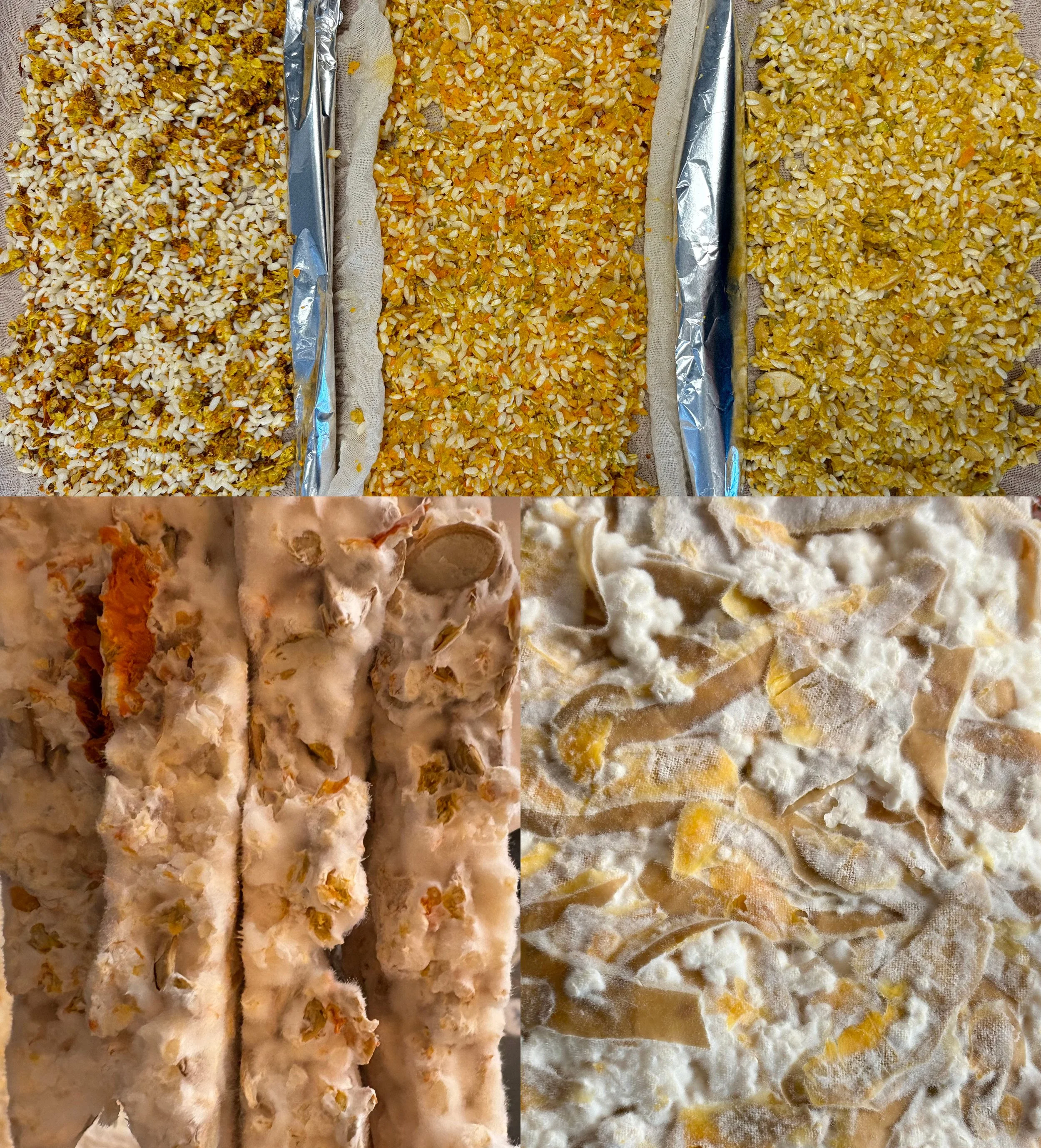Pumpkin trim shio kōji
This is part of our series on upcycling fruit & vegetable by-products.
Table of Contents
Strained pumpkin trim shio kōji made with pumpkin skin, guts and seeds
i. Introduction
Shio kōji is a Japanese umami seasoning made by fermenting kōji, salt and water. It is often sold as a strained and sometimes clarified liquid, but can also be used as a porridge-like slurry. In either form, it is widely used as a marinade to tenderise and enhance the flavour of meat, fish and vegetables, adding umami, richness and depth to (and drawing them out from) the raw ingredients.¹
In this version, we include roasted pumpkin trimmings to create a shio kōji that is particularly nutty and toasted, which can be used like a traditional shio kōji to add savoury complexity to dishes. By making a liquid condiment, we can use the rich proteinous seeds, which are otherwise largely inedible due to their fibrous nature. Shio kōji’s quick fermentation time also avoids off-flavours that come from oxidised pumpkin seed oil.
We also have a miso recipe that uses pumpkin trimmings, showing how versatile umami sources can be created from the same by-products for different applications.
Some of the different combinations of pumpkin trimmings that Nurdin and Kim worked on
ii. Recipe
Ingredients
500g, or 1 part, Japanese short grain rice, soaked overnight in 650g or 1.3 parts water, then drained
500g, or 1 part, pumpkin trim (seeds, guts and skin)
2g kōji (Aspergillus oryzae) spores, or 0.2% by mass of rice–pumpkin trim mixture
water, equal to the weight of the finished kōji
100g, or 5% by mass, salt²
Method
Roughly chop the pumpkin trim in a Robot-Coupe or similar food processor, then spread it in an even layer on a baking tray and dry-roast it in a preheated oven at 160°C for 20 minutes.
Mix the soaked rice and roasted pumpkin trim in a bowl, then spread evenly on a perforated tray lined with muslin cloth. Steam this rice–pumpkin mixture: we did so in a Rational combi-oven on the full steam setting at fan speed 4 for 40 minutes. Remove the steamed mixture from the oven and allow it to cool to 35°C.
Inoculate the cooled rice–pumpkin mixture with the kōji spores, mixing by gloved hand to evenly distribute them. Before inoculating, ensure all tools, surfaces and hands are sterilised to prevent contamination. Wrap the inoculated mixture in a moist muslin cloth that has been pre-boiled and wrung out. Ferment in a Rational oven or climate-controlled fermentation chamber at 32°C with 70% relative humidity for 42 hours, allowing the kōji to grow.
Remove the finished kōji from the oven or fermentation chamber and reweigh it. Blend it with an equal weight of water and 5% salt (based on the total weight of kōji and water).
Sterilise a large fermentation vessel using alcohol or boiling water. Allow to evaporate if the former, and to cool if the latter. Pour in the kōji–brine mixture and cover the vessel mouth with a fresh, dry muslin cloth.
Ferment at room temperature for 7 days, either stirring daily with a sterilised spoon, or sealing and gently shaking the vessel to redistribute the solids and liquids.
Once fermentation is complete, strain the mixture through fine muslin cloth or centrifuge to separate the solids. Retain the liquid. The shio kōji can be refrigerated for up to 1 month or frozen for longer storage. Refrigeration and freezing slow down but do not completely stop the microbial and enzymatic activity. For a shelf-stable product, seal the shio kōji in an airtight jar or vacuum bag and heat in a water bath or steam at 90°C for 40 minutes to pasteurise, denature enzymes and arrest further activity. The shio kōji can be heat-treated if used as a seasoning (still delicious), but not if you intend to use the active enzymes e.g. for a tenderising marinade.
Growing kōji on pumpkin trimmings
iii. Adaptations
Kim and Nurdin trialled shio kōji made from different combinations of pumpkin trimmings e.g. skin only, seeds only, seeds and guts, and all trimmings. The recipe shared above was their favourite.
Many other combinations produced excellent results, some sweeter and fruitier (e.g. 1 part rice : 1 part pumpkin skin) and others richer and more deeply umami (e.g. 50 parts rice : 47 parts pumpkin skin : 3 parts seitan flour). If not using the seeds, the addition of extra protein-rich ingredients (like seitan flour) is important to compensate for the lower protein content of the seedless trimmings. The dry-roasting stage is important as some microbes can survive in the seeds if just steamed and create mousiness, and it also gives a pleasant nutty flavour.
Use this recipe as a starting point to experiment with different grain kōjis, combinations of trimmings, and varieties of pumpkin/squash. The proportions of pumpkin trimmings depend on the variety: for example, we found that butternut squash consists of ~16% usable trimmings by mass (~11% skin and ~5% seeds and guts), whereas Hokkaido squash consists of ~30% usable trimmings by mass (~13% skin and ~17% seeds and guts).
Depending on which combination of pumpkin trimmings you used, you may be able to upcycle the reserved solid by-product produced after straining the mixture. However, if using the seeds, these solids will not be edible as they contain lots of insoluble fibrous hemicellulose and lignins. But they will be great for compost!
Comparison of different strained shio kōjis and their solid components
Contributions & acknowledgements
Kim performed the original culinary R&D, with further testing conducted by Nurdin, who documented the process through notes and photography. Eliot wrote the article using these notes and following further discussion with Nurdin and Kim, with contributions and editorial feedback from Josh.
Nurdin and Eliot photographed the pumpkin skin shio kōji R&D process and final product in our food lab.
Related posts
Endnotes
[1] For a more in-depth introduction to shio kōji see: How To Make Shio Koji 塩麹の作り方, Just One Cookbook.
[2] Shio kōjis can vary in their saltiness. Those with lower salt concentration will ferment more, while those with a higher salt concentration will ferment less and be more stable. This is the salt percentage we like here, but it could be adjusted if desired.







